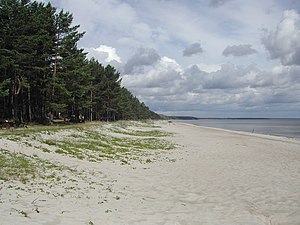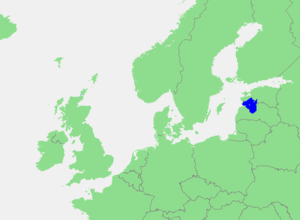Gulf of Riga
| Gulf of Riga | |
|---|---|
| Waters | Baltic Sea |
| Land mass | Northeast Europe |
| Geographical location | 57 ° 38 ' N , 23 ° 35' E |
| width | (E-W) 137 km |
| depth | (N-S) 174 km |
| surface | 16,300 km² |
| Greatest water depth | 67 m |
| Medium water depth | 26 m |
| Islands | Runo , Kühno |
| Tributaries | see text |
|
Gulf of Riga |
|
The Gulf of Riga , sometimes better known as the Bay of Riga , is a large bay in the Baltic Sea between Latvia and Estonia .
Other names are German Riga Bay , Estonian Liivi laht , Latvian Rīgas jūras līcis , Russian Рижский залив (Rižskij zaliv) and Latin Sinus magnus Livoniae or Mare Livonicum . Some names refer to the landscape of Livonia or Vidzeme , which borders to the east, while the coast of Courland lies in the southwest .
From the rest of the Baltic Sea, the Gulf of Riga is bounded by the Estonian islands Saaremaa (Ösel) (with the Sworbe peninsula ) and Moon . The bay is connected to the actual Baltic Sea via the Irben Strait and the Moon Sound . The Gulf of Riga has a maximum sea depth of 67 meters and covers a total area of around 16,300 km². The largest north-south extension is 174 km, in east-west direction it is 137 km.
The most important cities on the Gulf of Riga are the Latvian capital Riga and the Estonian port city Pärnu (Pernau) . The islands of Runö and Kühnö (both in Estonia) are located in the Gulf of Riga .
Important tributaries are:
- Lielupe (German: Kurländische Aa )
- Daugava (German: Düna )
- Gauja (German: Livländische Aa )
- Salaca (German: Salis )
- Pärnu (German: Pernau )
- Irbe (German: Irben )


